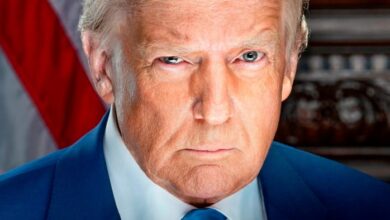The stock market crash has pushed Wall Street’s ‘fear gauge’ to a four-year high.


Wall Street’s infamous ‘fear index’ spiked on Monday, hitting its highest level since 2020 as stocks around the world plunged.
The CBOE The volatility index, or VIX, measures the implied volatility of the S&P 500 over the next 30 days based on market prices for options. A higher value on this ‘fear gauge’ signals higher expected volatility (ie: rapidly changing stock prices) and general uncertainty about the future.
The VIX spiked to a peak of 65.70 on Monday morning, before paring some of its gains to hit 36 at 11:30 a.m. ET. That’s still higher than Friday’s reading of just over 23 and just 12 at the start of the year.
VIX peaked above 85 in March 2020 following the COVID-19 lockdown.
Monday’s surge came as the Dow Jones Industrial Average fell 2.5%, while the S&P 500 fell 2.6% and the tech-heavy index Nasdaq Composite down sharply by 2.9%.
Paul Christopher, global head of investment strategy at Wells Fargo The Investment Institute cited several reasons for the market’s dismal performance and rising investor fears on Monday in a note to clients seen by Reuters. Luck. The combination of disappointing earnings among some tech and consumer-focused companies, escalating tensions in the Middle East and recent data that has shown widespread weakness in the economy are all to blame, he said.
After repeatedly surprising experts with its resilience, the US economy has recently shown signs of a sharp downturn. The July jobs report was much weaker than expected last week, with the US economy adding 114,000 jobs, compared to economists’ consensus forecast of 175,000. The unemployment rate also rose to 4.3%, triggering one of the most accurate recession indicators, the infamous Sahm Rule.
“The immediate implication is that investors are concerned that the economy could weaken rapidly and want the Fed to cut rates aggressively to sustain economic growth,” explained Wells Fargo’s Christopher.
The global stock market crash, however, began in Japan on Monday, when the Nikkei 225 fell 12% in its worst day since 1987. Some have suggested that so-called “carry trades” may have been to blame for Japan’s Black Monday.
For years, traders have borrowed money in Japan, where interest rates are low, and then used that money to buy assets abroad. But with the Bank of Japan raising interest rates last week and most Western countries cutting rates, that trading activity is no longer what it used to be.
“[T]“This market volatility is largely due to the reversal of global arbitrage and the reassessment of the AI craze,” said Jim Smigiel, chief investment officer at SEI, which manages, advises or operates about $1.5 trillion in assets. Luck through an emailed statement.
Smigiel pointed to the ISM services report, which measures activity in 15 non-manufacturing industries in the United States, as evidence that the current market sell-off is not based entirely on recession fears. The ISM Services Purchasing Managers’ Index rose to 51.4 in July, indicating the sector expanded for the 47th time in 50 months. That’s far from the typical reading in a recession.
Smigiel said he expects the Fed to cut rates two to three times, by 25 basis points, over the rest of the year amid the current market turmoil, but he opposes an emergency rate cut at the meeting, as Wharton professor Jeremy Siegel suggested on Monday.
“Frankly, this sell-off is overdone. The Fed’s emergency rate cut is priced in as meaningless given the economic backdrop in the US and would only undermine the credibility of the policymaker,” he argued.




